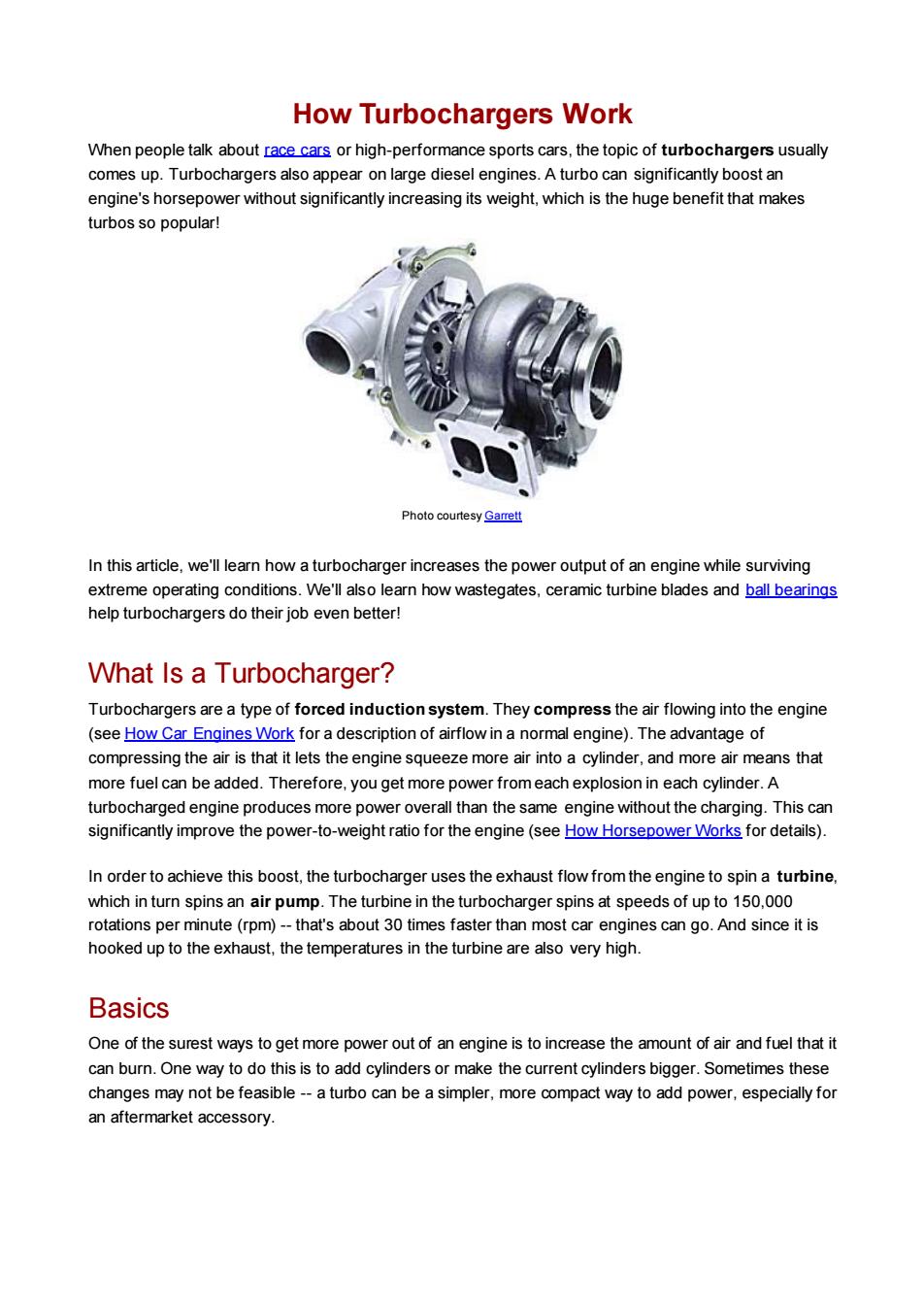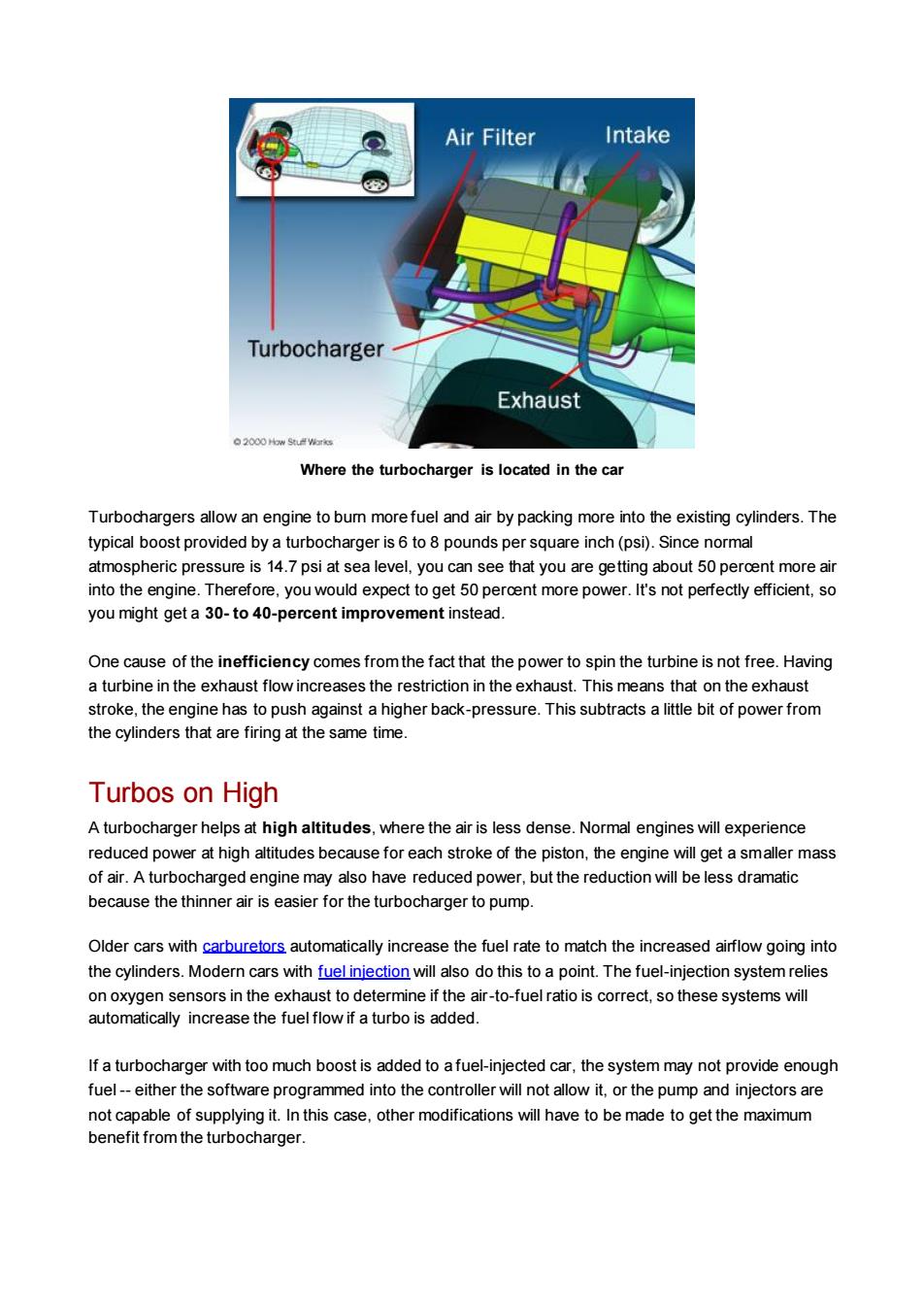
HowTurbochargersWorkWhenpeopletalkaboutrace cars orhigh-performancesportscars,thetopicofturbochargersusuallycomes up.Turbochargersalsoappear onlargedieselengines.Aturbocan significantlyboostanengine's horsepower without significantly increasing its weight, which is the huge benefit that makesturbos sopopular!PhotocotesyGarrettIn this article, we'll learn how a turbocharger increases the power output of an enginewhile survivingextremeoperating conditions.We'll also learn howwastegates,ceramic turbineblades and ball bearingshelpturbochargersdotheirjobevenbetter!WhatIs a Turbocharger?Turbochargersareatypeofforced inductionsystem.Theycompresstheairflowing intotheengine(seeHowCarEnginesWorkforadescriptionofairflowinanormalengine).Theadvantageofcompressingtheairis that it letstheenginesqueezemoreair intoa cylinder,and moreairmeans thatmore fuel can be added.Therefore,you get more power fromeachexplosion in each cylinder.Aturbochargedengineproducesmorepoweroverall thanthesameenginewithoutthecharging.Thiscansignificantlyimprovethepower-to-weightratiofortheengine(seeHow HorsepowerWorksfordetails).Inordertoachievethisboost,theturbochargerusestheexhaustflowfromtheengineto spina turbine,which in turn spins an air pump. The turbine in the turbocharger spins at speeds of up to 150,000rotationsperminute(rpm)--that'sabout3otimesfasterthanmostcar enginescango.And since itishooked up to the exhaust, the temperatures in the turbine are also very highBasicsOne of the surest ways to get more power out of an engine is to increase the amount of air and fuel that itcanburn.Onewaytodothisistoaddcylindersormakethecurrentcylindersbigger.Sometimesthesechangesmaynotbefeasible--aturbocanbeasimpler,morecompactwaytoaddpower,especiallyforanaftermarketaccessory
How Turbochargers Work When people talk about race cars or high-performance sports cars, the topic of turbochargers usually comes up. Turbochargers also appear on large diesel engines. A turbo can significantly boost an engine's horsepower without significantly increasing its weight, which is the huge benefit that makes turbos so popular! Photo courtesy Garrett In this article, we'll learn how a turbocharger increases the power output of an engine while surviving extreme operating conditions. We'll also learn how wastegates, ceramic turbine blades and ball bearings help turbochargers do their job even better! What Is a Turbocharger? Turbochargers are a type of forced induction system. They compress the air flowing into the engine (see How Car Engines Work for a description of airflow in a normal engine). The advantage of compressing the air is that it lets the engine squeeze more air into a cylinder, and more air means that more fuel can be added. Therefore, you get more power from each explosion in each cylinder. A turbocharged engine produces more power overall than the same engine without the charging. This can significantly improve the power-to-weight ratio for the engine (see How Horsepower Works for details). In order to achieve this boost, the turbocharger uses the exhaust flow from the engine to spin a turbine, which in turn spins an air pump. The turbine in the turbocharger spins at speeds of up to 150,000 rotations per minute (rpm) - that's about 30 times faster than most car engines can go. And since it is hooked up to the exhaust, the temperatures in the turbine are also very high. Basics One of the surest ways to get more power out of an engine is to increase the amount of air and fuel that it can burn. One way to do this is to add cylinders or make the current cylinders bigger. Sometimes these changes may not be feasible - a turbo can be a simpler, more compact way to add power, especially for an aftermarket accessory

IntakeAir FilterTurbochargerExhaust2Wheretheturbocharger islocated inthecarTurbochargersallowan enginetobumnmorefuel andairbypackingmoreintotheexistingcylinders.Thetypical boost provided bya turbocharger is 6 to 8 pounds per square inch (psi). Since normalatmospheric pressure is 14.7psi at sea level,you can see that youaregettingabout50percent moreairinto the engine.Therefore,you would expect to get 50 percentmore power.It's not perfectly efficient, soyoumightgeta30-to40-percent improvementinsteadOnecauseof the inefficiencycomes fromthefactthatthe powerto spin the turbine is notfree.Havingaturbine inthe exhaustflowincreasestherestrictionintheexhaust.This means thatontheexhauststroketheenginehastopushagainstahigherback-pressure.This subtractsa littlebit ofpowerfromthe cylinders thatarefiring at thesametime.Turbos on HighAturbochargerhelpsathighaltitudes,wheretheairislessdense.Normal engineswill experiencereducedpowerathighaltitudesbecauseforeachstrokeofthepiston,theenginewillgetasmallermassof air.A turbocharged engine may also have reduced power,but thereduction will be less dramaticbecause the thinner air is easierfor theturbochargerto pump.Oldercarswithcarburetorsautomaticallyincreasethefuel ratetomatchtheincreasedairflowgoing intothecylinders.Moderncars withfuel iniection will also dothistoa point.Thefuel-injectionsystemrelieson oxygen sensors in the exhaust to determine if the air-to-fuel ratio is correct, so these systems willautomatically increasethefuelflowifaturbo is added.If aturbochargerwithtoomuchboost is addedtoafuel-injectedcar,thesystemmaynot provideenoughfuel-- either the software programmed into thecontrollerwill not allow it, or the pump and injectors arenotcapableofsupplyingit.Inthiscase,othermodificationswillhavetobemadetogetthemaximumbenefitfromtheturbocharger
Where the turbocharger is located in the car Turbochargers allow an engine to burn more fuel and air by packing more into the existing cylinders. The typical boost provided by a turbocharger is 6 to 8 pounds per square inch (psi). Since normal atmospheric pressure is 14.7 psi at sea level, you can see that you are getting about 50 percent more air into the engine. Therefore, you would expect to get 50 percent more power. It's not perfectly efficient, so you might get a 30- to 40-percent improvement instead. One cause of the inefficiency comes from the fact that the power to spin the turbine is not free. Having a turbine in the exhaust flow increases the restriction in the exhaust. This means that on the exhaust stroke, the engine has to push against a higher back-pressure. This subtracts a little bit of power from the cylinders that are firing at the same time. Turbos on High A turbocharger helps at high altitudes, where the air is less dense. Normal engines will experience reduced power at high altitudes because for each stroke of the piston, the engine will get a smaller mass of air. A turbocharged engine may also have reduced power, but the reduction will be less dramatic because the thinner air is easier for the turbocharger to pump. Older cars with carburetors automatically increase the fuel rate to match the increased airflow going into the cylinders. Modern cars with fuel injection will also do this to a point. The fuel-injection system relies on oxygen sensors in the exhaust to determine if the air-to-fuel ratio is correct, so these systems will automatically increase the fuel flow if a turbo is added. If a turbocharger with too much boost is added to a fuel-injected car, the system may not provide enough fuel - either the software programmed into the controller will not allow it, or the pump and injectors are not capable of supplying it. In this case, other modifications will have to be made to get the maximum benefit from the turbocharger

HowIt WorksTheturbochargerisboltedtotheexhaustmanifold oftheengine.Theexhaustfromthecylinders spinstheturbine,which works like agasturbineengine.Theturbineisconnectedbya shafttothecompressor, which is located between the air filter and the intake manifold.The compressorpressurizes theairgoing into thepistons.CompressedAirFlowEngrgeCylindeOillnletCheage AlrWrireCompreExhausmGasAirInletDischargeCrmgrssorWastegateOilOitiotImagecourtesyGaettHowaturbocharger isplumbed inacarTheexhaustfromthecylinderspassesthroughtheturbineblades,causingtheturbinetospin.Themore exhaustthatgoesthroughtheblades,thefasterthey spin.COMPRESSORTUOSINIESECTIONHOUSNESSORHLAUSTSUTLETTURENETUREINETURBINEAIRIDSERARBESECTIONMERFSORMCOEERESSORNEImagecourtesyGarmeftInsidea turbochargerOntheotherendoftheshaftthattheturbine isattachedto,thecompressor pumps air into the cylinders. The compressor is a type ofcentrifugalpump--itdrawsairinatthecenterofitsblades and flings itoutwardasitspinsInordertohandlespeedsof upto150,000rpm,theturbineshafthastobesupportedverycarefully.Mostbearingswouldexplodeatspeedslikethis,so mostturbochargersuseafluid bearing.Thistypeofbearing supportstheshaftonathinlayerofoilthat is constantlyPhoto courtesy Garrettpumpedaroundtheshaft.Thisservestwopurposes:Itcoolsthe shaftTurbocompressorbladesandsomeoftheotherturbochargerparts,anditallowstheshafttospin
How It Works The turbocharger is bolted to the exhaust manifold of the engine. The exhaust from the cylinders spins the turbine, which works like a gas turbine engine. The turbine is connected by a shaft to the compressor, which is located between the air filter and the intake manifold. The compressor pressurizes the air going into the pistons. Image courtesy Garrett How a turbocharger is plumbed in a car The exhaust from the cylinders passes through the turbine blades, causing the turbine to spin. The more exhaust that goes through the blades, the faster they spin. Image courtesy Garrett Inside a turbocharger On the other end of the shaft that the turbine is attached to, the compressor pumps air into the cylinders. The compressor is a type of centrifugal pump - it draws air in at the center of its blades and flings it outward as it spins. In order to handle speeds of up to 150,000 rpm, the turbine shaft has to be supported very carefully. Most bearings would explode at speeds like this, so most turbochargers use a fluid bearing. This type of bearing supports the shaft on a thin layer of oil that is constantly pumped around the shaft. This serves two purposes: It cools the shaft and some of the other turbocharger parts, and it allows the shaft to spin Photo courtesy Garrett Turbo compressor blades

withoutmuchfriction.There are many tradeoffs involved in designing a turbochargerfor an engine. In the next section, we'lllookatsomeofthesecompromisesandseehowtheyaffectperformance
without much friction. There are many tradeoffs involved in designing a turbocharger for an engine. In the next section, we'll look at some of these compromises and see how they affect performance